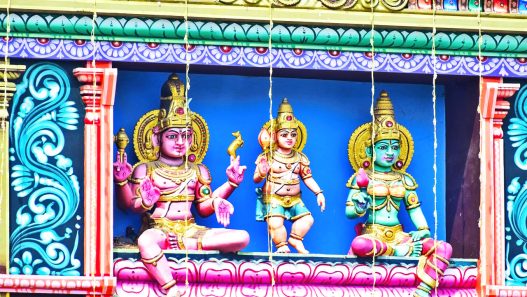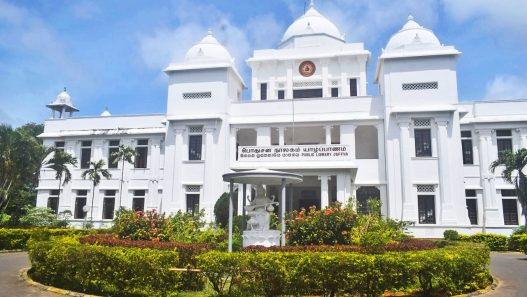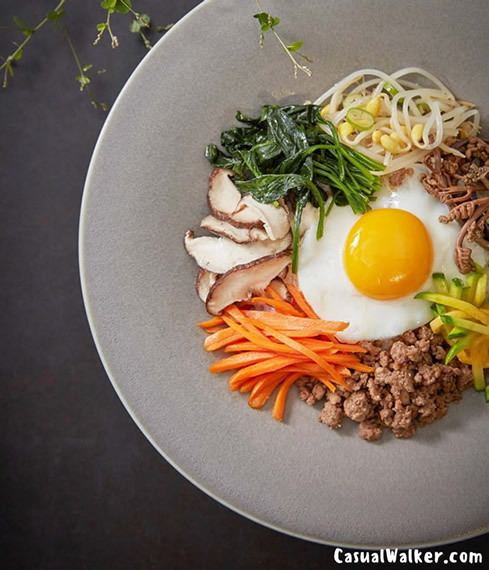Event Details:
InKo Centre, in association, with Korea Tourism Organization, is delighted to present The Korean culinary series – Korean Cooking for Indian Homes– with delectable recipes that can easily be made in Indian homes.
Korean traditional cuisine or Hansik represents the metaphysical view of Koreans – the theory of yin and yang (representing earth and heaven respectively) and the interaction between the two resulting in dynamic energies represented by the five elements that make up the universe (i.e., water, fire, wood, metal and earth). The traditional Korean table consists of dishes of five colours, namely, green, red, yellow, white, and black, which represent the five elements and also the five tastes of spicy, sweet, sour, bitter, and salty. It is believed that a combination of dishes with these colours provides nutritional balance. A good example is bibimbap, which is rice mixed with assorted vegetables of different colours, egg and gochujang (red pepper paste). The main cooking techniques used by Koreans are grilling, boiling, pan-frying and steaming which do not use much so make the food healthy and easily digestible. The staple inclusions of cuisine Korean are Kimchi, Gochujang (Red Pepper Paste), Doenjang & Ganjang (Soybean Paste) (Soy Sauce).
Since ancient times, people in Korea, as indeed in India, have maintained a belief that food and medicine have the same origin and hence perform the same function, following the adage that ‘food is the best medicine’. With harvests from lush green rice paddies, sun-drenched tangerine orchards, and mountain valley chili pepper farms, Korean food exudes freshness. It delights the senses, invigorates the palate – and invites foodies to explore regional variations.
Korean Cooking for Indian Homes, a booklet prepared by the Korea Tourism Organisation, is intended as a guide for people who may want to try cooking Korean food at home. The recipes included in this book have been slightly modified to suit the Indian palate and availability of ingredients. All recipes included in this book have been sourced from www.hansik.org – managed by the Korea Food Promotion Institute, a public institution established with the purpose of promoting and globalizing Korean food.
In an episodic series, we introduce 10 recipes that could easily be prepared in Indian homes. We begin with Beachu Kimchi (Cabbage Kimchi) and Japchae (Glass noodles with sautéed vegetables) with the recipe, cooking instructions and useful tips.
With approximately 5000 years of culinary history, the cultural importance of food in Korea, extends well beyond nourishment. When friends and colleagues greet each other in the morning, they ask, “Did you eat breakfast?”. This is considered as much of a greeting as it is an inquiry. Korean traditional cuisine or Hansik represents the metaphysical view of Koreans – the theory of yin and yang (representing earth and heaven respectively) and the interaction between the two resulting in dynamic energies represented by the five elements that make up the universe (i.e., water, fire, wood, metal and earth).
The traditional Korean table consists of dishes of five colours, namely, green, red, yellow, white, and black, which represent the five elements and also the five tastes of spicy, sweet, sour, bitter, and salty. It is believed that a combination of dishes with these colours provides nutritional balance. A good example is bibimbap, which is rice mixed with assorted vegetables of different colours, egg and gochujang (red pepper paste). Main cooking techniques used by Koreans are grilling, boiling, pan-frying and steaming which do not use much so make the food healthy and easily digestible.
InKo Centre – Korean culinary series – Korean Cooking for Indian Homes: Video Episode 1
Korean Traditional Cuisine – Description:
Basics for Korean Cooking
Kimchi
Now beginning to gain worldwide reputation as a representative food of Korea, kimchi has been praised for its anti-carcinogenic properties and nutritional value. Kimchi can be eaten fresh but is normally consumed after fermenting it for several days. Made with vegetables and a variety of seasoning ingredients, kimchi was an important source of vitamins in the winter, when fresh vegetables were unavailable and at a time when storage methods were not well-developed. There are over three hundred varieties of kimchi, but when it was first made, it required a very simple recipe of salting and storing Napa cabbage in a ceramic container for fermentation.
Gochujang (Red Pepper Paste)
Gochujang is a traditional Korean condiment made by fermenting a mixture of chili pepper powder with other ingredients. This red pepper paste is used for stews, soups, fried food, salads, grilled food, and namul (wild greens). It is also used in making fried red pepper paste sauce for side dishes, and can be served with raw fish or mixed noodles.
Doenjang & Ganjang (Soybean Paste) (Soy Sauce)
Made of fermented soybeans which are divided into solid and liquid parts to respectively form doenjang and ganjang, these are two of the most important items of traditional Korean food.
Doenjang is usually used in cooking stews and also served as a condiment for ssam (leaf wraps), or namul (wild greens) and jang-tteok (wheat flour pancakes).
Ganjang is used variously depending on the cooking method and also used as an accompaniment for fried food.
InKo Centre – Korean culinary series – Korean Cooking for Indian Homes: Video Episode 2
Korean Traditional Cuisine – Description:
HAEMUL PAJEON (Seafood Scallion Pancake)
Haemul-pajeon is a savoury pancake with plenty of green onion and seafood coated with mushy dough and beaten egg on the top.
Koreans often associate pajeon with rain – and this coupled with makgeolli (rice wine), is a favourite rainy-day snack! This association is because of the sound of raindrops hitting the ground or a window sill reminds people of the sizzle of spattering oil as the pajeon is fried!
DAK GALBI (Spicy Stir-fried Chicken)
Chopped chicken is marinated in gochujang (red chilli paste) seasoning and stir-fried on a heated oiled frying pan with various vegetables such as cabbage and sweet potato.
Originated in the city of Chuncheon in Gangwon province, Dak-galbi is best paired with Makguksu (buckwheat noodles with vegetables) and is a nationwide favourite, especially if you are on a tight budget!
Where to buy your Korean ingredients:
Physical Stores
Chennai
• Seoul Store, Shop No.43 & 44, Ground Floor, 96, Kaveri Complex, Nungambakkam High Road, Chennai
• Commercial Plaza, 1 & 2, Temple Green, Sriperumbudur, Chennai
• 2/185, East Coast Road, Sakthi Vinayakar Nagar, Injambakkam, Chennai
• New 74, Old 58, 2nd Main Road, Near Grand Sweets, Gandhi Nagar, Adyar, Chennai
Delhi/NCR:
• Kim’s Mart, LG 59, DT Mega Mall, DLF, Phase-1, Golf Course Road, Gurgaon
• Seela Korean Food Mart, LG-14, South Point Mall, Golf Course Road Gurgaon
• Epicure Food & Wine, Lower Ground Floor, South Point Mall, Golf Course Road, Gurgaon
• Ichiba Food Store, LG-4, South Point Mall, Sector 53, Golf Course Road, Gurgaon
• BG Food Mart, 1A, Arjun Nagar, Safdarjung Enclave, New Delhi
Online Stores
• www.amazon.in/koreanstore
• www.koreanshop.in
InKo Centre – Korean culinary series – Korean Cooking for Indian Homes: Video Episode 3
Korean Traditional Cuisine – Description:
BIBIM-GUKSU (Spicy noodles)
This cold noodle salad is made by tossing kimchi, cucumber and lettuce and cooked noodles along with a seasoning sauce made of gochujang (red chili pepper paste) and vinegar or soy sauce for serving.
Originally a dish for the royal table and thus made with several expensive ingredients, Bibim-guksu is now considered a summertime favourite. With generous portions of cucumber, this dish helps to cool down an overheated body, to quench thirst and to relieve swelling.
JJIMDAK (Spicy braised chicken with noodles and vegetables)
Jjimdak is a braised chicken dish made with chicken, various vegetables marinated in a ganjang (Korean soy sauce) based sauce.
Originating from Andong, North Gyeongsang Province, Jjimdak is popular as a side dish and as a snack, served with or without alcoholic beverages.
Where to buy your Korean ingredients:
Physical Stores
Chennai
• Seoul Store, Shop No.43 & 44, Ground Floor, 96, Kaveri Complex, Nungambakkam High Road, Chennai
• Commercial Plaza, 1 & 2, Temple Green, Sriperumbudur, Chennai
• 2/185, East Coast Road, Sakthi Vinayakar Nagar, Injambakkam, Chennai
• New 74, Old 58, 2nd Main Road, Near Grand Sweets, Gandhi Nagar, Adyar, Chennai
Delhi/NCR:
• Kim’s Mart, LG 59, DT Mega Mall, DLF, Phase-1, Golf Course Road, Gurgaon
• Seela Korean Food Mart, LG-14, South Point Mall, Golf Course Road Gurgaon
• Epicure Food & Wine, Lower Ground Floor, South Point Mall, Golf Course Road, Gurgaon
• Ichiba Food Store, LG-4, South Point Mall, Sector 53, Golf Course Road, Gurgaon
• BG Food Mart, 1A, Arjun Nagar, Safdarjung Enclave, New Delhi
Online Stores
• www.amazon.in/koreanstore
• www.koreanshop.in
InKo Centre – Korean culinary series – Korean Cooking for Indian Homes: Video Episode 4
Korean Traditional Cuisine – Description:
SUNDUBU-JJIGAE (Spicy Soft Tofu Stew)
Sundubu-jjigae is a stew of soft tofu and clams in a spicy broth. Soft tofu is made with soaked soyabean and is soft in texture and sweet in taste.
Typically assembled and cooked directly in the serving vessel, sundubu-jjigae is generally quite spicy and has been described by the New York Times as “the ideal winter meal”.
BIBIMBAP (Rice mixed with Vegetables and Meat)
Various marinated and/or cooked vegetables and stir-fried meat or shitake mushrooms are tossed thoroughly with cooked rice with the addition of gochujang (red chili pepper paste) as a seasoning condiment.
Though a common meal in every Korean household, Bibimbap is most famous in the city of Jeonju, where the Jeonju Bibimbap Festival is held with great fanfare, every year.
Where to buy your Korean ingredients:
Physical Stores
Chennai
• Seoul Store, Shop No.43 & 44, Ground Floor, 96, Kaveri Complex, Nungambakkam High Road, Chennai
• Commercial Plaza, 1 & 2, Temple Green, Sriperumbudur, Chennai
• 2/185, East Coast Road, Sakthi Vinayakar Nagar, Injambakkam, Chennai
• New 74, Old 58, 2nd Main Road, Near Grand Sweets, Gandhi Nagar, Adyar, Chennai
Delhi/NCR:
• Kim’s Mart, LG 59, DT Mega Mall, DLF, Phase-1, Golf Course Road, Gurgaon
• Seela Korean Food Mart, LG-14, South Point Mall, Golf Course Road Gurgaon
• Epicure Food & Wine, Lower Ground Floor, South Point Mall, Golf Course Road, Gurgaon
• Ichiba Food Store, LG-4, South Point Mall, Sector 53, Golf Course Road, Gurgaon
• BG Food Mart, 1A, Arjun Nagar, Safdarjung Enclave, New Delhi
Online Stores
• www.amazon.in/koreanstore
• www.koreanshop.in
InKo Centre – Korean culinary series – Korean Cooking for Indian Homes: Video Episode 5
Korean Traditional Cuisine – Description:
Since ancient times, people in Korea, as indeed in India, have maintained a belief that food and medicine have the same origin and hence perform the same function, following the adage that ‘food is the best medicine’.
With harvests from lush green rice paddies, sun-drenched tangerine orchards, and mountain valley chili pepper farms, Korean food exudes freshness. It delights the senses, invigorates the palate – and invites foodies to explore regional variations.
Korean Cooking for Indian Homes, a booklet prepared by the Korea Toursim Organisation, is intended as a guide for people who may want to try cooking Korean food at home. The recipes included in this book have been slightly modified to suit the Indian palate and availability of ingredients.
All recipes included in this book have been sourced from www.hansik.org – managed by the Korea Food Promotion Institute, a public institution established with the purpose of promoting and globalizing the traditions of Korean food.
In an episodic series we introduce 10 recipes that could easily be prepared in Indian homes. The series examines cuisine as a unique cultural signpost and a conduit for meaningful cultural exchange. In Episode 5, the final episode of this series, we introduce Sujeonggwa (Cinnamon Punch with Dried Persimmons) and Yaksik (Sweet Rice with Nuts and Jujubes). Along with the recipe, cooking instructions and useful tips, details are provided as to where the ingredients can be sourced at physical stores in Chenni, New Delhi, as well as online.
About Korea Tourism Organization:
Korea Tourism Organization (KTO) is a government organization representing Korea in the field of tourism and culture. It has offices all over the world. KTO, New Delhi, promotes Korea as a world class travel destination in India through joint promotions with travel agents, advertisements across all kinds of media, support extended to incentive groups and by providing information to tourists and travel agents about Korea. KTO, New Delhi also provides Indian travel agents with complimentary literature on tourism.
About InKo Centre
InKo Centre is a registered, non-profit society supported primarily by TVS Motor Company Limited and Hyundai Motor India Limited; the Korean Association in Chennai and a host of Indian and Korean companies based in Chennai. The Centre works in close co-operation with the Embassy of the Republic of Korea, New Delhi; the Korean Cultural Centre, New Delhi and the Consulate General of the Republic of Korea in Chennai. Since its inception in 2006, the Centre has worked consistently with key organizations in Korea and in India, with an aim to build long-term sustainable intercultural partnerships between the two countries. We showcase the entire range of performing and visual arts programmes that link key Indian and Korean artists and organisations in a meaningful and sustainable manner. We present regular programmes at our Centre as well as large-scale projects in association with partner organisations, at external venues, on a regular basis.
Event Date / Time:
Wednesday, 23 December 2020 | Time: 6.00 p.m. IST
Location: Online
Similar Photo Stories you may like to Visit:
Korean Color : Curated by Insang Song – Art Exhibition, InKo Centre

Similar Famous Delicious & Tasty Eat outs:
Best Food Trucks in Chennai – Finding the Top Food on Wheels in Chennai – Visit, Travel Guide



















